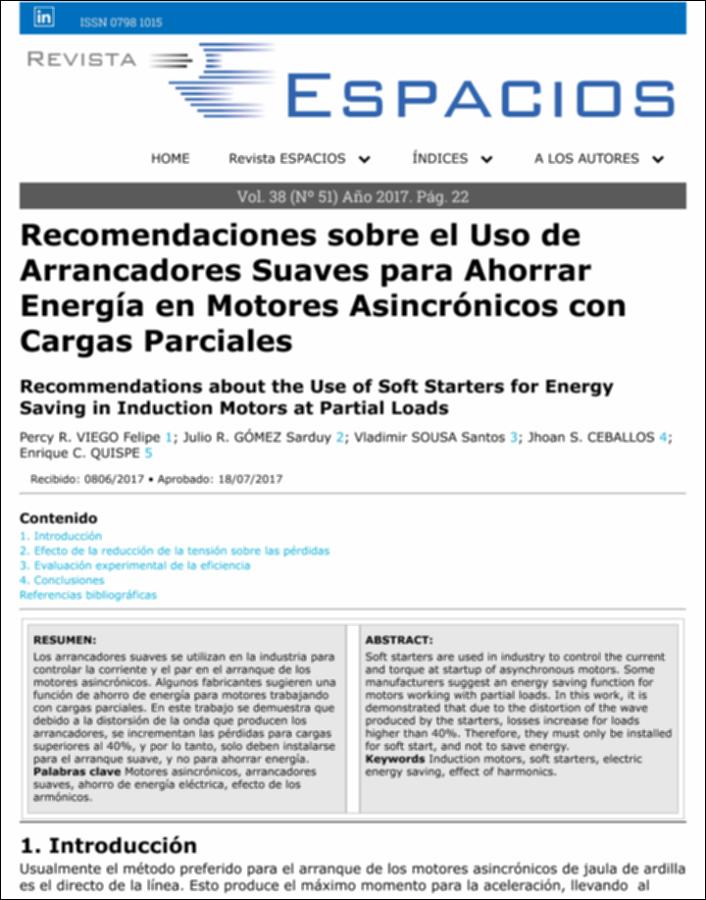Mostrar el registro sencillo del ítem
Recomendaciones sobre el uso de arrancadores suaves para ahorrar energía en motores asincrónicos con cargas parciales
| dc.contributor.author | Viego Felipe, Percy R. | spa |
| dc.contributor.author | Gómez Sarduy, Julio R. | spa |
| dc.contributor.author | Sousa Santos, Vladimir | spa |
| dc.contributor.author | Ceballos, Jhoan S. | spa |
| dc.contributor.author | Quispe, Enrique Ciro | spa |
| dc.date.accessioned | 2019-01-21T22:05:19Z | |
| dc.date.available | 2019-01-21T22:05:19Z | |
| dc.date.issued | 2017-07-18 | |
| dc.identifier.issn | 07981015 | spa |
| dc.identifier.uri | http://hdl.handle.net/11323/2029 | spa |
| dc.description.abstract | Los arrancadores suaves se utilizan en la industria para controlar la corriente y el par en el arranque de los motores asincrónicos. Algunos fabricantes sugieren una función de ahorro de energía para motores trabajando con cargas parciales. En este trabajo se demuestra que debido a la distorsión de la onda que producen los arrancadores, se incrementan las pérdidas para cargas superiores al 40%, y por lo tanto, solo deben instalarse para el arranque suave, y no para ahorrar energía. | spa |
| dc.description.abstract | Soft starters are used in industry to control the current and torque at startup of asynchronous motors. Some manufacturers suggest an energy saving function for motors working with partial loads. In this work, it is demonstrated that due to the distortion of the wave produced by the starters, losses increase for loads higher than 40%. Therefore, they must only be installed for soft start, and not to save energy. | eng |
| dc.language.iso | spa | |
| dc.publisher | Espacios | spa |
| dc.rights | Atribución – No comercial – Compartir igual | spa |
| dc.subject | Effect of harmonics | spa |
| dc.subject | Electric energy saving | spa |
| dc.subject | Induction motors | spa |
| dc.subject | Soft starters | spa |
| dc.subject | Motores asincrónicos | spa |
| dc.subject | arrancadores suaves | spa |
| dc.subject | ahorro de energía eléctrica | spa |
| dc.subject | armónicos | spa |
| dc.title | Recomendaciones sobre el uso de arrancadores suaves para ahorrar energía en motores asincrónicos con cargas parciales | spa |
| dc.type | Artículo de revista | spa |
| dc.rights.accessrights | info:eu-repo/semantics/openAccess | spa |
| dc.identifier.instname | Corporación Universidad de la Costa | spa |
| dc.identifier.reponame | REDICUC - Repositorio CUC | spa |
| dc.identifier.repourl | https://repositorio.cuc.edu.co/ | spa |
| dc.relation.references | AGOSTINHO, Fabio, R., Della ROCCA, Graciela, A., FERREIRA, Fernanda, C. y STEFENON, Stéfano, F. Estudo sobre a viabilidade financeira na atualização tecnológica de uma planta fabril: Utilização de motores elétricos de alta eficiência e iluminação LED. Revista Espacios. Vol 38, Año 2017, Número 12, Pág. 5. Recuperado de: http://www.revistaespacios.com/a17v38n12/17381205.html Gui, J., & Hong, S. (2009). Research on intelligent soft starter of asynchronous electromotor. En Global Congress on Intelligent Systems (pp. 303-307). Washington, USA: IEEE Computer Society. Institute of Electrical and Electronics Engineers. (2004). “IEEE Std 112, IEEE Standard test procedure for polyphase induction motors and generators”. International Electrotechnical Commission. (2010). “IEC, International Standard IEC 60034-1, Rotating electrical machines - Part 1: Rating and performance”. Kling, S. (2002). Arranque Suave. ABB Revista 1, 56-63. Köfler, H. (2004). Can solid state voltage regulation devices save energy in induction machines? An experimental proof with some theoretical explanations. En 16th International Conference on Electrical Machines, ICEM 2004 (pp. 318-325). Cracow, Poland. Leporace, M. (2013). Harmonic design considerations. Recuperado de http://www.geindustrial.com/publibrary/checkout/Harmonic? TNR=White%20Papers|Harmonic|generic Mõlder, H., Vinnal, T. & Beldjajev, V. (2010). Harmonic losses in induction motors caused by voltage waveform distortions. En Electric Power Quality and Supply Reliability Conference (PQ) (pp. 143-150). Kuressaare, Estonia. Quispe, E. C. (Junio/Julio, 2015). Recomendaciones para la aplicación de motores de alta eficiencia. Reportero Industrial, 83(3), 16-18. Slaets, B., Van Roy, P., & Belmans, R. (2000). Determining the efficiency of induction machines, converters and softstarters. Electromotion, 7(2), 73-80. Sousa, V., Viego, P. R., Gomez, J. R., Quispe, E. C., & Balbis, M. (Mayo, 2016). Shaft Power Estimation in Induction Motor Operating Under Unbalanced and Harmonics Voltages. IEEE Latin America Transactions, 14(5), 2309-2315. Viego, P.R. (2008). Selección de motores accionados con variadores de frecuencia. Energía y Tú, Abril-Junio, 21-24. Wen-Xiong, L., Jian-Guo, L., Ming-Sheng, L., & Jie, Z. (26-29 Agosto, 2004). Design of intelligent soft-start controller for induction motor. En International Machine Learning and Cybernetics (pp. 908 – 912). Shanghai, China. Zenginobuz, G., Çadırcı, I., Ermis, M., & Barlak, C. (Septiembre/Octubre, 2001). Soft starting torque induction motors at constant current with minimized starting torque pulsations. IEEE Trans on Industry Applications, 37(5), 1334-1347. | spa |
| dc.title.translated | Recommendations about the use of soft starters for energy saving in induction motors at partial loads | spa |
| dc.type.coar | http://purl.org/coar/resource_type/c_6501 | spa |
| dc.type.content | Text | spa |
| dc.type.driver | info:eu-repo/semantics/article | spa |
| dc.type.redcol | http://purl.org/redcol/resource_type/ART | spa |
| dc.type.version | info:eu-repo/semantics/acceptedVersion | spa |
| dc.type.coarversion | http://purl.org/coar/version/c_ab4af688f83e57aa | spa |
| dc.rights.coar | http://purl.org/coar/access_right/c_abf2 | spa |
Ficheros en el ítem
Este ítem aparece en la(s) siguiente(s) colección(ones)
-
Artículos científicos [3156]
Artículos de investigación publicados por miembros de la comunidad universitaria.

